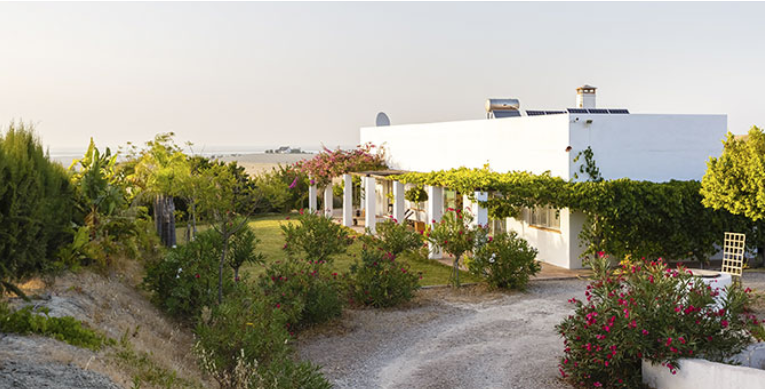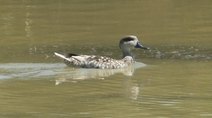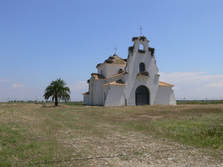 El Martinete Guest House (Photo Juan Martín Bermúdez)
El Martinete Guest House (Photo Juan Martín Bermúdez)  Marbled Teal - Trebujena Marshes
Marbled Teal - Trebujena Marshes  La Señuela Church
La Señuela Church | Birding Cadiz Province |
|
|
Whilst there's no doubt that the raptor migration across the straits is the 'jewel in the crown' of Cadiz birding, that doesn't mean it's sensible to concentrate solely on the jewel and forget the crown! Yet that often seems to be what many visitors seem todo and, by ignoring the delights available elsewhere in the province, they are really missing out on some terrific birding. Personally, I've found that having a base in Alcala de los Gazules (i.e. in the centre of the province) maximises flexible birding options since most birding hotspots are within an hour's drive (and some a good deal less). The downside is that by not being at the focus of bird migration, the Straits, I can't step out of my door and witness the really impressive streams of raptors that you get on the coast (although I see enough to satisfy most!) Then again, being based near Tarifa means up to a two hours drive to reach some key sites for rare or scarce species. My solution isn't the only one and there's much to be said for splitting your visit between two bases, one on the Straits and the other near the marshes of the Guadalquivir (and other wetlands and birding sites). The problem has been that there's been no really "birder friendly" accommodation in the Sanlucar area where it's really needed ….. until now!  El Martinete Guest House (Photo Juan Martín Bermúdez) El Martinete Guest House (Photo Juan Martín Bermúdez) It gives me great pleasure to be able to warmly recommend El Martinete Guest House (http://www.martinete.eu) near Trebujena. Not only is it in a pleasant location with superb views across the Guadalquivir but it's also under the care and direction of Juan Martín Bermúdez. That he's a highly expert and knowledgeable birder (and former Director of the Coto Ornithological Donana station) would alone be recommendation enough but he's also a fluent English speaker, the author of several wildlife guides, founder of the innovative Salarte project (see www.salarte.org) and a thoroughly pleasant chap. Casa Martinete itself is a charming well equipped three bedroom villa ideally situated to explore the lower Guadalquivir. It's a great base from which to 'do your own thing' but if you need expert guidance then Juan Martin is available as your mentor and guide (the "Wildlife Experiences" bit on their logo). I know that admitting that there's more to life than birds is a cardinal sin for some but staying here also allows you to explore the magical cultural and gastronomic delights of the Jerez area. If like me, you're a lover of history and good sherry (there's no other kind!), as well as birds, then there's nowhere better to explore. When you half close your eyes and squint at that fabulous view across the lower Guadalquivir, you can almost see a galley pulling towards Tartessus, the near-mythical and certainly mysterious harbour city that was once here (which was quite possibly the model for Atlantis).  Marbled Teal - Trebujena Marshes Marbled Teal - Trebujena Marshes Being based here means that the excellent birdwatching to be had along the Guadalquivir between Trebujena and Bonanza is only a few minutes away. Birding along this stretch of river ending up at Algaida Pinewoods and Bonanza saltpans (c40 mins drive … if you don't stop to look at the birds!) is one of my favourite birding routes in Cadiz province. It offers the chance of scarce and local species like Marbled Teal, White-headed Duck, Pin-tailed Sandgrouse, Lesser Short-toed Lark and Azure-winged Magpie (the only site in the province but often very difficult!) not found near Tarifa plus delights like Flamingos, Collared Pratincoles and much else. Bonanza saltpans are also probably the best site in the region for photographing waders.  La Señuela Church La Señuela Church The other bonus of being based here is that access to several other excellent birding sites is much more convenient than from Tarifa; Mesas de Asta Marsh (Spain's largest Gull-billed Tern colony) is 15 mins away, Chipiona area (regular rarities & Little Swift) 40 mins, Laguna de Tollos (an exciting newly restored wetland) 40 mins and Brazo del Este (wetland birds and exotics) less than an hour. The drive along the Carr. de Práctico beside the river Guadalquivir north from Trebujena to Brazo del Este is little known but a wonderfully shady excursion on a bright sunny day with plenty of pleasant spots for a picnic and even more marshy margins for birds. On this route at La Señuela, the old church provides a most picturesque site for nesting White Storks. Brazo del Este is a key site for waders, Marbled Teal, small crakes, Savi's Warbler, Black-headed Weaver and other exotics. Even Osuna, the best place in western Andalucia for Black-bellied Sandgrouse, Great and Little Bustards, is only a manageable 90 minutes. Grazalema (Black Wheatears, Rock Sparrow, Bonelli's Eagle, Alpine Accentor, etc) is also only 90 minutes or so. For all of these localities, you have to add at least 60-90 mins travelling time to reach them from the Tarifa area which makes a trip to them more of an expedition than a jaunt. Not that you miss out entirely on raptor migration if based further north in the province since, whilst you may not see the impressive streams of migrating birds you get along the straits, the same species often use the Guadalquivir as a flyway so you can catch up with all the species (except Ruppell's Vulture and Bonelli's Eagle) that you can expect around Tarifa. Besides, if conditions are looking good for a serious passage across the Straits then it's only 90 minutes or so away and Juan Martin will surely tip you off when it's a good time to give it a go. So if you're planning a birding trip to Cadiz province – and why wouldn't you? - remember that you don't have to follow the herd down to Tarifa and that you can have a wonderful and equally memorable time exploring the lower Guadalquivir and nearby sites. You'll probably return home with a longer list of birds – not to mention other species – than if you'd been based around Tarifa. Better still, if you're a tyro birdwatcher then you can avail yourself of the services of an authoritative and knowledgeable guide.
1 Comment
|
About me ...Hi I'm John Cantelo. I've been birding seriously since the 1960s when I met up with some like minded folks (all of us are still birding!) at Taunton's School in Southampton. I have lived in Kent , where I taught History and Sociology, since the late 1970s. In that time I've served on the committees of both my local RSPB group and the county ornithological society (KOS). I have also worked as a part-time field teacher for the RSPB at Dungeness. Having retired I now spend as much time as possible in Alcala de los Gazules in SW Spain. When I'm not birding I edit books for the Crossbill Guides series. CategoriesArchives
May 2023
|